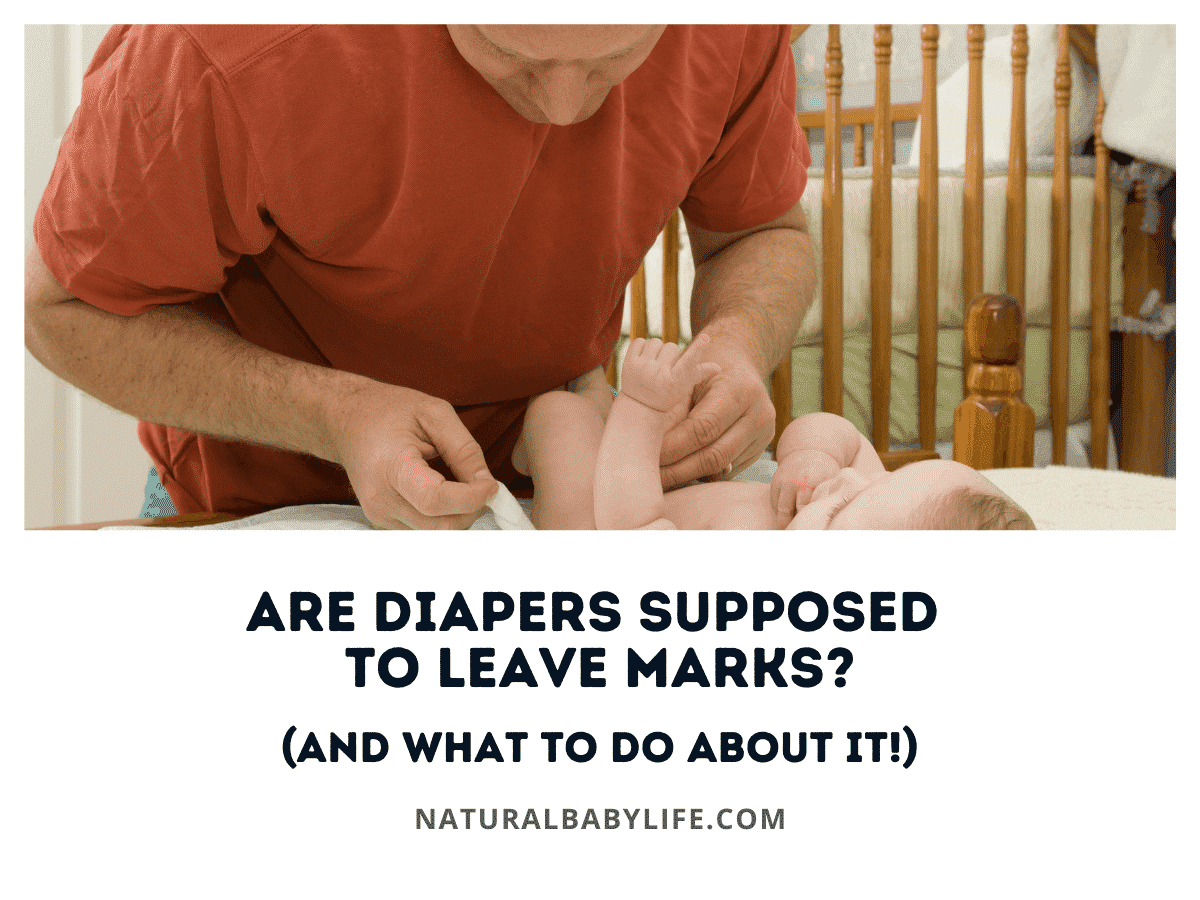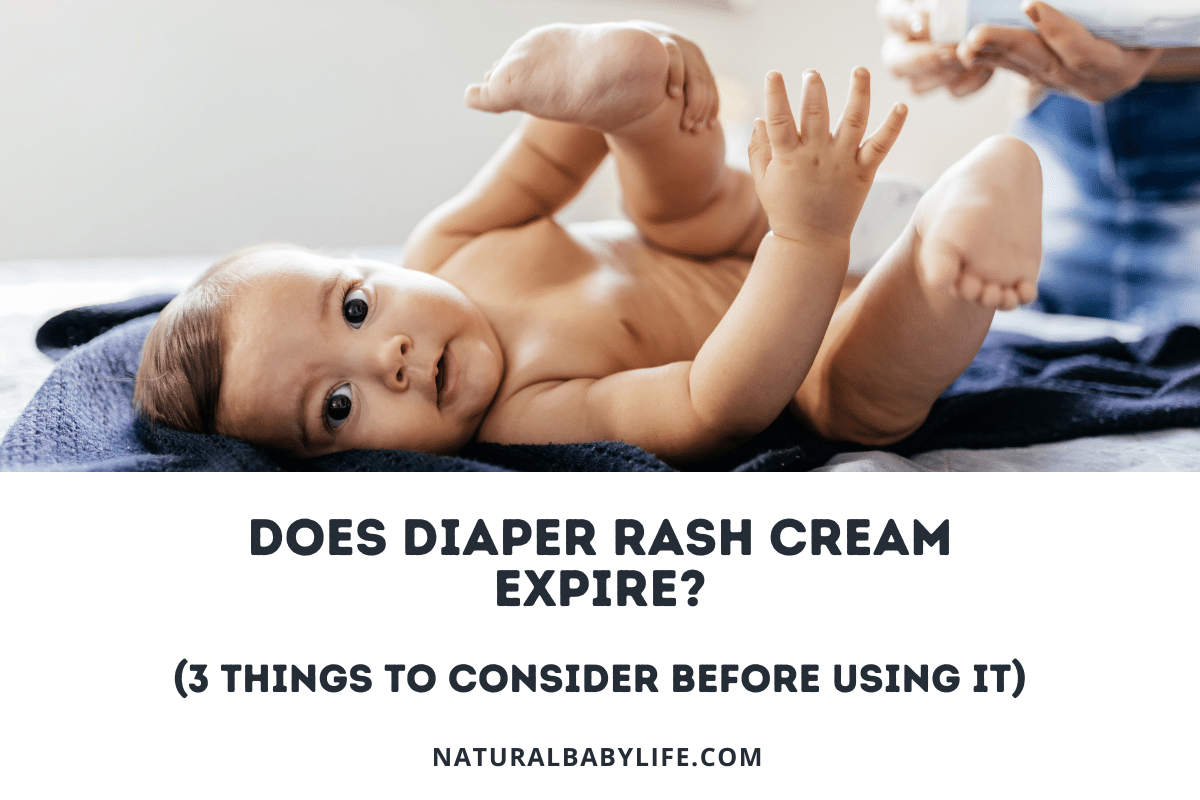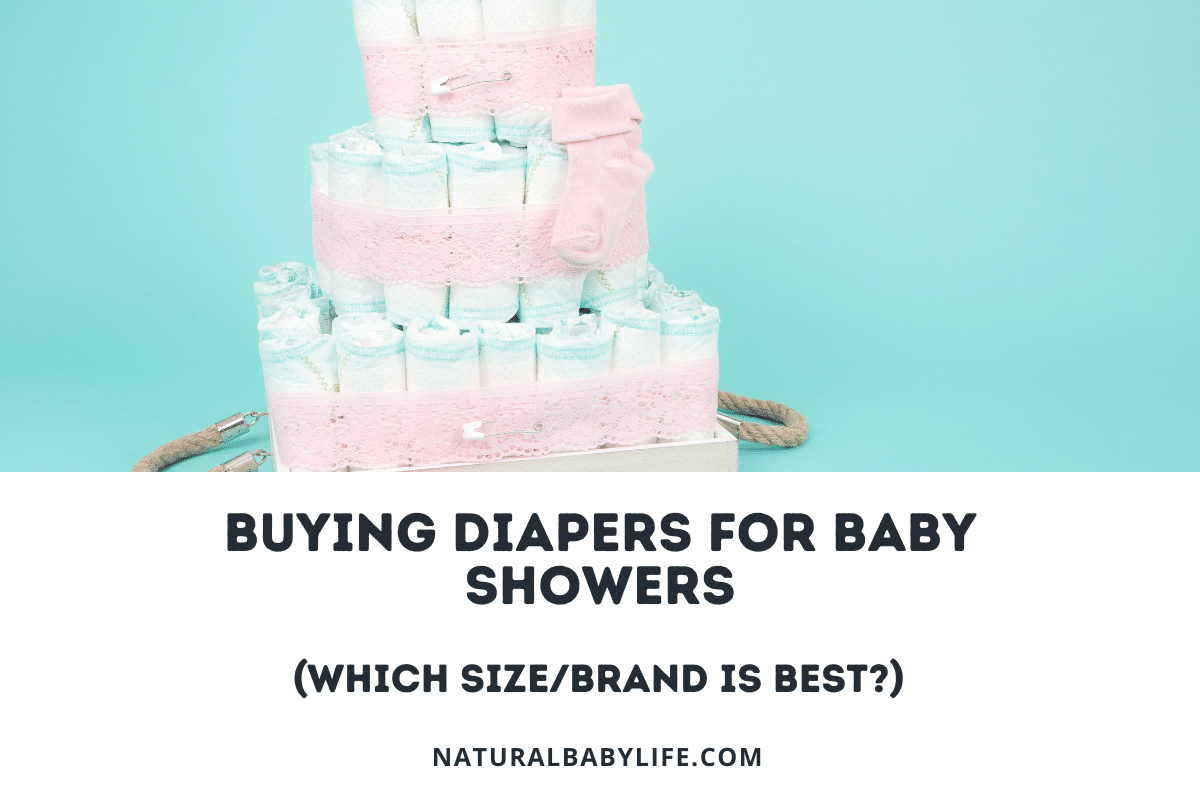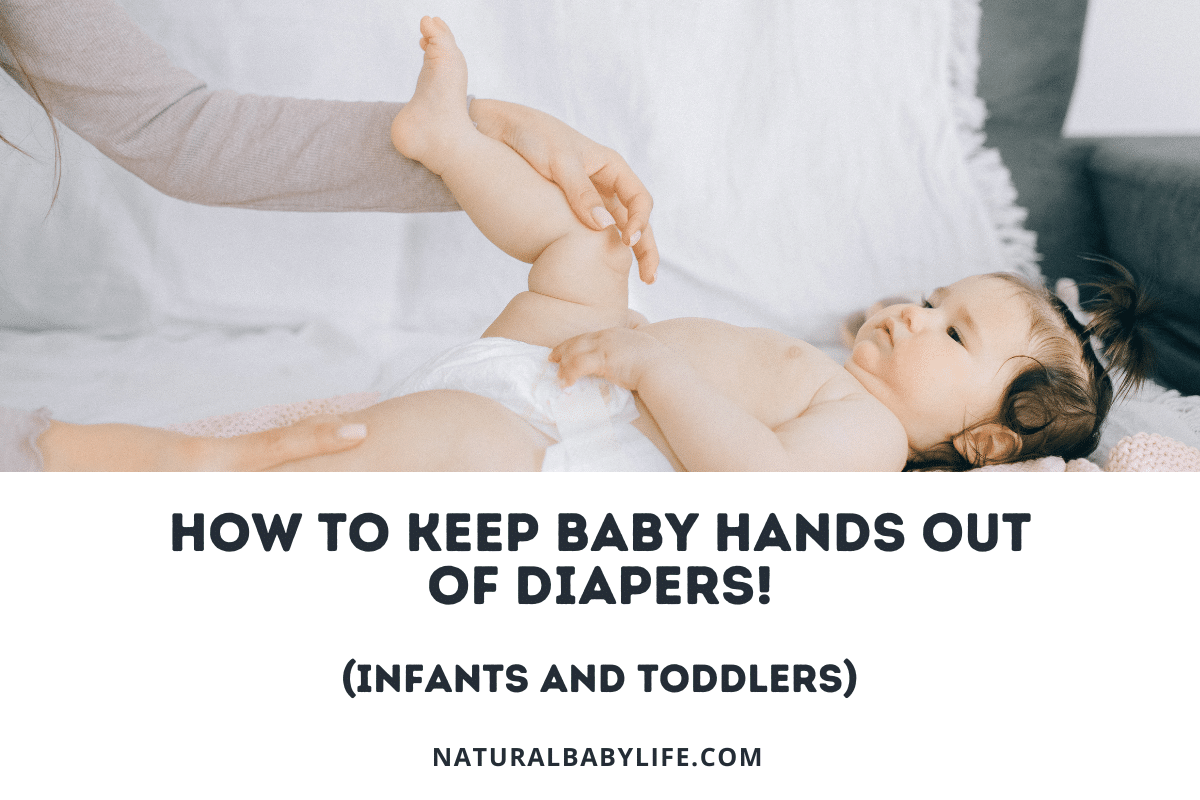Diaper change probably isn’t your favorite thing to do with your sweet baby, but what do you do when you find out that her diaper is leaving red marks?
If your baby’s diaper is leaving marks because the diaper is too tight, you will see signs that the elastic is pressing into the skin of her thigh, but not across her butt. If, however, the mark is across her entire butt, the issue is an irritation caused by the diaper not being changed soon enough or a reaction to chemicals in the diaper itself.
Keep reading to learn the likely causes of marks on your baby’s diaper and how to make them go away.
Table of Contents
Should diapers leave marks on my baby?
Diapers should not leave marks on your baby.
If your baby’s diapers are leaving marks, there is something amiss. The type of mark will help you determine the cause of the problem so that you can rectify it.
For example, red marks around your baby’s thigh may mean that she has outgrown the diaper and needs a larger size while a rash across the entire bottom could indicate that the diaper was left on too long or that the diaper itself is irritating your baby’s sensitive skin.
Generally speaking, as long as you are using a high-quality, natural diaper that is the right size and fits your baby’s body type you shouldn’t have issues with marks on your baby’s body. I recommend the Pampers Pure line of diapers and wipes as a budget-friendly option for natural baby products – we’ve used this brand a TON over the years with excellent results.
Depending on the type of mark the diaper is leaving on your baby, you may have to narrow down the options and test out a few solutions before the problem is solved. No matter what, the relief both you and your baby feel once the diaper is no longer causing trouble will make the effort worthwhile.
What causes diaper marks?
In general, the causes of diaper marks can be classified as either pressure, such as an ill-fitting diaper, or irritation which, among other things, can be caused by allowing pee or poop to sit on the baby’s skin.
Diaper is too tight
This issue is more common than you think!
If you can see the imprint of the diaper in your baby’s skin or there is a ring of irritation around her thighs, it may be time to move up to the next size diaper. The best indicator for what size your baby should be wearing is the actual fit of the diaper.
Diapers sizes vary by brand, but check the box and you’ll see the weight range that size should fit. Keep in mind though that a very long, slim baby may wear a size longer than indicated by her weight, while a chunkier baby may need to size up before hitting the weight threshold.
Pants are too tight
This issue could be easily overlooked!
If the diaper isn’t too right, it’s possible that the indentations are being left by a snug pants band pushing the diaper into the skin.
Make sure that the clothing your baby has outgrown is being packed away, passed on, or sold instead of staying in the nursery with her other clothes. It is far too easy to grab the wrong pair of pants when you’re in the midst of changing a wiggly baby.
Different infants grow at different rates, so do a visual check to ensure clothing fits properly. Pants should be snug but not tight, especially around the waistband, and long pants should hit at the ankles.
Diaper is on wrong
Let’s be honest – it’s hard to put a diaper on a wiggly, squiggly, screaming baby. It’s doubly difficult in the middle of the night when your sleep cycle has been abruptly disrupted. It’s not really that uncommon for a diaper not to be put on exactly right every single time.
Sometimes you know the diaper is on wrong, sometimes it’s part of a learning experience. Either way, if the diaper is not aligned correctly, you could be losing valuable absorbancy or it could be pressing uncomfortably on a part of your baby’s skin it doesn’t typically belong, either of which could lead to skin irritation or red marks.
Diaper is not being changed properly/often enough
As a parent, it can sometimes be tough to remember the last time you changed your baby’s diaper but NEVER leave poop in there for long!
Allowing pee or poop to sit against your baby’s skin for an extended period of time will certainly lead to a diaper rash.
Unfortunately, it’s not always possible to stop and change your baby’s diaper immediately after an accident. Once you are able to clean her up, apply a cream or ointment to help soothe the rash.
If you notice that the rash isn’t going away even after treatment and regular changes, you may want to double-check your method. You should use as many wet wipes as necessary to completely clean the diaper area, ensuring that you are wiping from front to back to avoid getting fecal matter in the vaginal or scrotum area.
Skin sensitivity
There are several different kinds of diaper rash, most of which are from medical conditions that can be exacerbated by exposure to any chemicals that may be in your baby’s diaper or from her own pee or poop.
Some common types of diaper rash caused by sensitive skin include:
- Yeast infections – Caused by an overgrowth of the fungi called Candida that lives on the skin in the diaper area, a yeast infection may appear as fluid-filled blisters or a red rash that is inflamed. Yeast infections are common after a diaper rash the cracked and bled. Most diaper rash creams will treat a yeast infection if the area is kept clean and dry, but if the area doesn’t improve within a few days, see a doctor.
- Eczema – This can occur on many spots on the infant’s body including the diaper area. It is characterized by red patches or hard scaly skin that is painful in the diaper area. Moisturizes will usually soothe it, but that can also cause other issues so a steroid cream or something stronger may need to be recommended by a doctor.
- Skin infections – Your baby may develop a bacterial infection that causes red, swollen skin in the diaper area. Infants with bacterial infections will probably have a fever and will appear to be sick. Your pediatrician can prescribe antibiotics to prevent secondary infections.
- Intertrigo – This is a more severe secondary yeast or bacterial infection in the skin folds and warm wet areas like buttocks and thigh areas. It requires more frequent diaper changes and tends to lead to adult life with inflammatory rashes.
- Psoriasis – Thick, scaly patches of skin develop from this rash that appears to be an itch that is pink or gray. It can appear anywhere on the body, but the scalp is the most common. There are different treatments like steroid creams and prescriptions to treat it after instances like a wet diaper triggers the flare of psoriasis.
How to prevent diaper marks
Once you narrow down or determine the cause of the marks your baby’s diaper is leaving on her skin, you can work on correcting the problem.
Use the right size diaper
This is the single most important thing to get right.
Of all the problems that might be leading to a diaper leaving red marks on your baby, this is probably the easiest to solve. If your baby’s diaper is leaving marks on her, especially a red band around each thigh, it’s time to go up a size.
Not all diapers are designed the same, however. If the diaper doesn’t fit properly, but is loose in some places and tight in others, you may need to experiment with a different brand altogether until you find one that better fits your baby’s body type.
Even if your baby falls within the weight range the diaper should fit, you may need to go up a size. A long, skinny baby may fit into a smaller size diaper longer than a stockier baby even if they weigh the same
How do I know when my baby needs the next size diaper?
In addition to red marks on your baby’s hips and thigh, here are some other common signs that she’s outgrown her diaper:
- Coverage – The diaper should cover your baby’s entire bottom. It is important to have full coverage to keep from having leaks. If leaks start to happen or the bottom does not look fully covered, it’s time to go up a size.
- Tab locations – Diapers are made to have the tabs close to the center of your baby’s belly. If the tabs are closer to the hips, it’s time to get a larger diaper.
- Waistband – The elastic waistband is supposed to be comfortable. Try sticking your fingers into the diaper and see if you can slightly pull away. If not, then your baby is probably uncomfortable and it’s time to go up a size.
- Package suggestions – Although the suggested weight for the diaper size isn’t the end-all-be-all of the fit, it is a good idea to keep an eye on the recommendation, especially if your baby’s size and development is fairly average.
Ensure the diaper is put on correctly
Diapers can be difficult to put on correctly, even if you’ve been doing it for a while.
Here are a couple of helpful tips to ensure that your baby’s diaper goes on right every time:
- Keep supplies together – If everything that is needed for a diaper change is together, it is easier to put the infant on the flat surface and do the change. This station should include the diaper and wipes, of course, but you should also make sure that there is a change of clothes as well as any cream or ointment you might need readily available.
- Hands-on all the time – With all the supplies being kept together one hand can be on the infant at all times, not looking around or reaching to get something. Keep one hand on them the entire time of removal of the dirty diaper and replacement when the clean diaper. This is not only important for your baby’s safety, but also helps keep her calm and in position.
- Hang a distraction – Babies tend to wiggle, squirm, and fight less when they have something to look at. Hang a toy or other distraction above the changing table and you’ll save yourself a lot of trouble.
- Finger test – Once the tabs are closed, do the finger test. Make sure the diaper is snug, but that you can still place your two fingers between the waist and the diaper comfortably.
Make sure pants fit properly
Baby clothes sizes are a recommendation and you know best when your child needs to stay in a size a little longer or go ahead and move up before the size indicates.
Pants (especially pajama pants) should fit snugly but not be tight. Once your little one’s calves are being exposed or you’re struggling to pull the waistband up over the diaper, it’s time to move up. This is especially important if you’ve chosen to use cloth diapers as they tend to add much more bulk than disposables and often have hard snaps that can dig into your baby’s skin.
Try out a diaper for sensitive skin
If you are using crappy diapers then making a change could definitely help with skin irritation.
If your family has a history of sensitive skin or your baby seems to be having a negative reaction to the diaper itself, you may need to try out a diaper designed specifically for sensitive skin. These diapers are usually made with plant-based fibers and are chlorine-free, fragrance-free, and hypoallergenic.
I generally recommend the Pampers Pure line of diapers and wipes as a budget-friendly option for parents looking for a more natural diaper. They work great and won’t break the bank!
Use a baby-friendly detergent
If your baby uses cloth diapers instead of disposables but is still having a reaction to the diaper itself, the culprit is probably your detergent. Even if you have stopped washing your baby’s clothes in a separate detergent, you should only use specific detergents on your baby’s diapers. (This one’s amazing!)
Avoid the temptation to use bleach on the diaper inserts if they’re starting to look grungy! If you’re really worried about the stains, try hanging them out to dry instead of running them through the dryer. They may not be quite as soft and fluffy, but the sun will help take the stain out.










